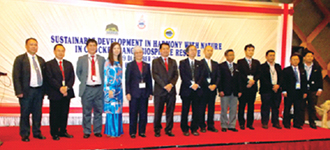Most catchments in Crocker buffer zone
Published on: Thursday, December 10, 2015

Kota Kinabalu: Most of the water catchments in the Crocker Range are located in its buffer zone, or sometimes jokingly called "battle zone", a seminar Wednesday entitled "Towards Sustainable Development in Harmony with Nature in Crocker Range Biosphere Reserve", heard. The buffer zone includes the controversial site of the proposed Kaiduan Dam.This fact underscores the critical importance of Unesco-recognised 350,584-hectare Crocker Range Biosphere Reserve (CRBR) which embraces an inhabited 60,313-hectare Buffer Zone and a 144,779-hectare Transition Zone which are strictly not part of the gazetted part of the park.
ADVERTISEMENT
But because the Unesco's Man and the Biosphere (MAB) Reserve programme dictates that both the Buffer Zone as well as the Transition Zone must be sustainably managed as a condition for such global recognition, the 350,584-hectare CRBR practically insures the future water security of one million West Coast folks of Sabah, key speakers pointed out. "A report from DID says that in the absence of a focus on sustainability, West Coast of Sabah could run out of water in 50 years," said Ludi Apin, Head of Crocker Range Park, in his presentation on the 'Overview of Crocker Range Biosphere Reserve'. Keynote speaker, Professor Hiroyuki Matsuda of Yokohama National University, who spoke on "Future Perspective of Unesco's Man and the Biosphere Programme – Towards Lima Action Plan", distinguished between 'Protection' and 'Conservation'."Protection means don't touch whereas Conservation means use for generations," he said, citing the concept behind the CRBR mirrors that of Japan's age Satoyma and Satoumi where both biodiversity and cultural diversity are simultaneously conserved through co-existence between man and nature."A scientific definition of Satoyma and Satoumi refers to a dynamic mosaic of managed socioecological system producing a bundle of ecosystem services for human wellbeing; enhancing biodiversity and primary production by sustainable human activities," Prof Hiroyuki said.
ADVERTISEMENT
In fact, between disturbance and succession, the experience in Germany shows under-use of High Nature Value presents problem, although Prof Hiroyuki did not elaborate. Meanwhile, Culture, Tourism and Environment Minister Datuk Seri Masidi Manjun reminded participants that "Unesco recognition also comes with responsibility to manage the CRBR in an integrated manner".
ADVERTISEMENT
"In this case, the responsibility to manage the biosphere reserve that consists the Core Zone, Buffer Zone and Transition Zone in a sustainable manner," said Masidi, whose speech was read by Deputy State Secretary Datuk Joseph Guntavid."Since it involves three categories of landscapes, sustainable manner requires the collective efforts of all relevant government agencies, NGOs and more importantly the people who are living within the CRBR. "And ultimately, the sea of people living outside it, too, since the area is going to be their main source of water for the whole of West Coast and the Interior of Sabah."Supporting the sustainable management of CRBR will not only benefit them with continuous supply of resources but will also protect them from natural disasters like landslides and floods, Masidi said."Opening the forests and removal of earth rampantly contributed to the occurrence of flood in recent years."Hundreds of millions of ringgit spent by the Government in building infrastructures in mitigating floods will not be enough if we keep cutting the forests and worse, if we cut down the hills altogether," Masidi said. The seminar was jointly organised by the Sabah Parks, the Natural Resources Office, Sabah and Japan International Co-operation Agency. Arrifin, Deputy Director of Natural Resource Office, delivered the welcome address. Stay up-to-date by following Daily Express’s Telegram channel.
Daily Express Malaysia




